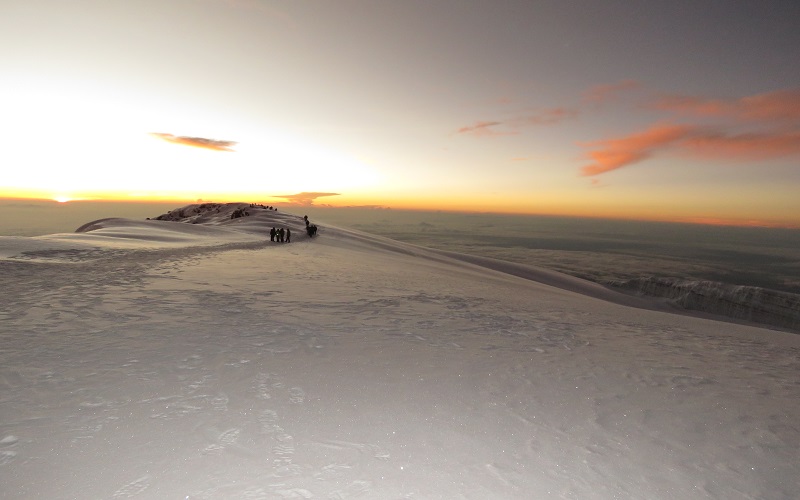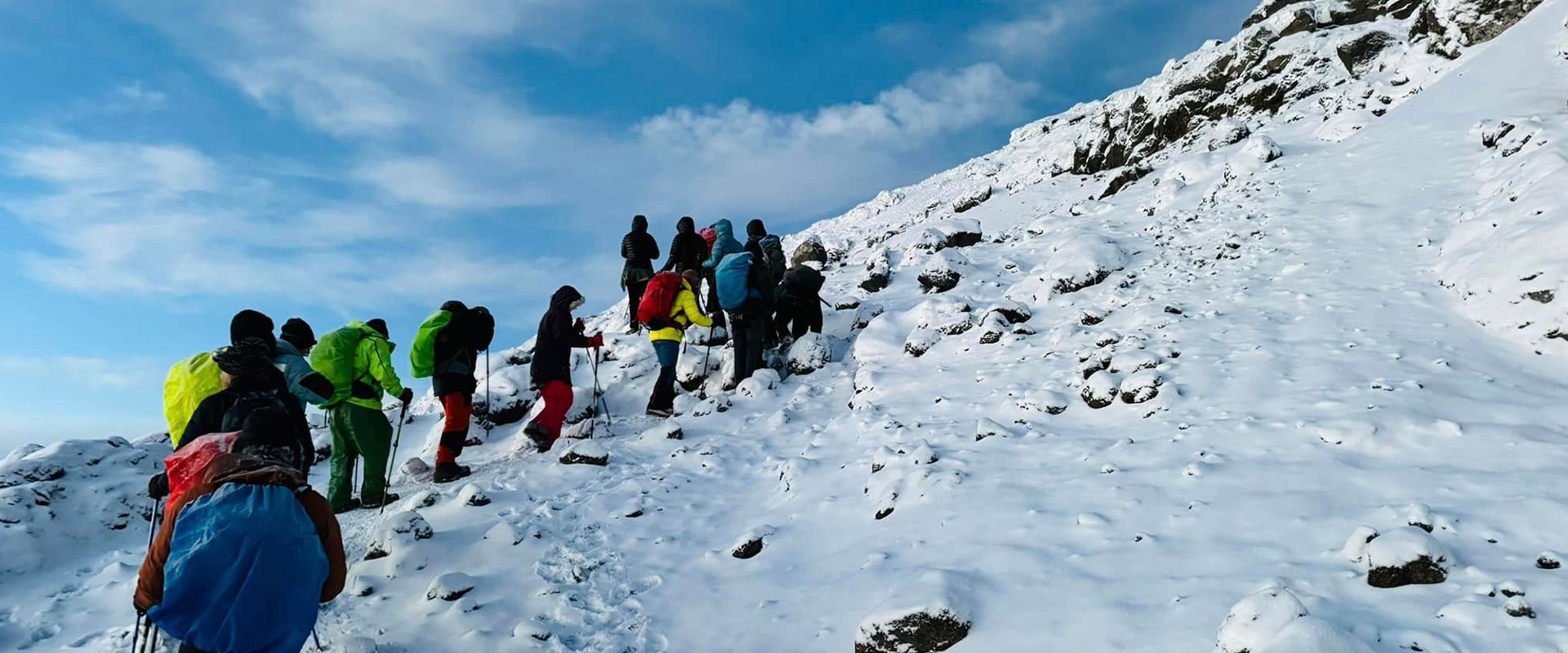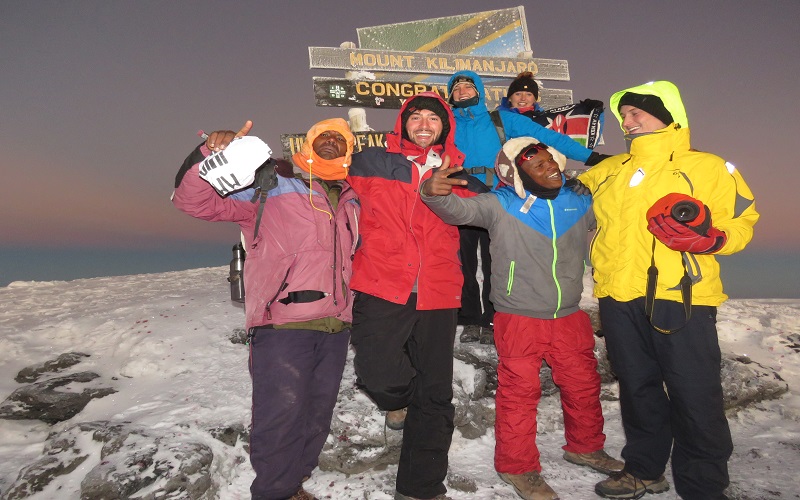
Best Mount Kilimanjaro Hiking Tour 2026–2027 | Machame Route 6 & 5 Days Climb
Feel the best Kilimanjaro hiking tour 2026–2027 via the Machame Route. Choose a 6 or 5-day climb to conquer Africa’s highest peak with stunning views and adventure.
Customer Reviews
4.9
Mount Kilimanjaro Hiking Tour via Machame Route 2026–2027
If you’re planning a Kilimanjaro hike in 2026 or 2027, the Machame Route is the perfect choice for both first-time and experienced climbers. Known as the “WhiskeyRoute”, it offers incredible scenery, good acclimatization, and a true sense of adventure.Climbing Mount Kilimanjaro is one of the most rewarding adventures in the world. Rising 5,895 meters above sea level, it’s Africa’s highest mountain and one of the world’s Seven Summits.
Whether you have six days to enjoy a relaxed journey or five days for a faster-paced climb, the Machame Route guarantees breathtaking landscapes, professional guiding, and an unforgettable experience at the top of Africa UhuruPeak.
Why Choose the Machame Route?: Scenic Adventure & Summit Success, the Most Scenic & Successful Route to Kilimanjaro Summit”
The Machame Route is the most popular and scenic trail on Mount Kilimanjaro, attracting thousands of climbers every year. It’s often called the “Whiskey Route” because of its challenging yet rewarding path that twists and turns through some of the most beautiful landscapes on the mountain.
The trail starts in lush rainforest, where you will hear the sounds of tropical birds and monkeys overhead. As you climb higher, the forest gives way to moors and alpine deserts, revealing dramatic rocky ridges and sweeping views of the surrounding valleys. One of the highlights is the Shira Plateau, a high-altitude plateau offering panoramic vistas that feel like stepping onto another planet.
What makes the Machame Route special is its“climb high, sleep low” approach. This technique allows your body to gradually adjust to higher altitudes by climbing to a higher elevation during the day and sleeping at a lower elevation at night. This significantly improves acclimatization, reduces the risk of altitude sickness, and increases your chances of successfully reaching Uhuru Peak.
Additional advantages of the Machame Route include:
· Variety of landscapes: From rainforests to alpine deserts, glaciers, and rocky summits.
· Higher summit success rate: Gradual ascent gives climbers a better chance of making it to the top.
· Adventure & excitement: Steep ridges, scenic scrambles, and dramatic ridgelines make every step memorable.
· Flexibility for climbers: Suitable for solo adventurers, couples, small groups, and even those with moderate hiking experience.
· Full support: Professional guides, porters, and cooks make the climb safe, comfortable, and enjoyable.
Whether you’re a first-time climber or an experienced trekker, the Machame Route offers a perfect blend of challenge, scenery, and adventure, making it the ideal choice for your Kilimanjarohiking tour in 2026–2027.
Highlights of the Machame Route:
- Amazing scenery from rainforest to alpine desert to glaciers.
- Excellent success rate due to good altitude acclimatization.
- Moderate difficulty - suitable for fit beginners and experienced hikers.
- Great adventure for solo travelers, couples, or small groups.
- Professional guides, cooks, and porters offering full mountain support.
Best Kilimanjaro Hiking Tour Itinerary: Machame Route 6 & 5 Days
In the sections below, you will find step-by-step daily plans for both the 6-day and 5-day Machame Route climbs. Each day highlights the trail’s scenery, elevation, and hiking time, along with key points like forest paths, high plateaus, and iconic landmarks such as Lava Tower and Barranco Wall. You will also see how the itinerary balances acclimatization, adventure, and rest, ensuring the best chance to reach the summit safely while enjoying breathtaking landscapes every step of the way. Whether you choose the longer 6-day climb for a relaxed pace or the faster 5-dayroute for an adventurous challenge, this guide gives you a clear picture of what to expect on your Kilimanjaro hiking tour.
6 Days Machame Route Itinerary
Day 1: Machame Gate to Machame Camp (3,010m)
The adventure begins at Machame Gate (1,800m). After registration, you will start your hike through a lush rainforest full of birds, monkeys, and tropical plants.
It’s a steady climb to Machame Camp, where you’ll spend your first night under the stars.
Hiking time: 5–6 hours
Day 2: Machame Camp to Shira Camp (3,840m)
You will leave the forest and enter the moorland zone. The trail becomes steeper, but the views open up beautifully. You will walk across ridges and valleys before reaching Shira Camp, located on a high plateau.
Hiking time: 4–5 hours
Day 3: Shira Camp to Barranco Camp (3,950m) via Lava Tower (4,630m)
This day helps with acclimatization. You will climb up to the Lava Tower before descending to Barranco Camp, surrounded by giant senecio trees.
Hiking time: 6–7 hours
Day 4: Barranco Camp to Barafu Camp (4,680m)
Climb the famous Barranco Wall, a fun and scenic scramble offering amazing views. The trail continues to Karanga Valley for lunch and then up to Barafu Camp, your base for the final ascent.
Hiking time: 7–8 hours
Day 5: Summit to Uhuru Peak (5,895m) and down to Mweka Camp (3,100m)
Start your summit attempt around midnight. With determination and teamwork, you’ll reach Uhuru Peak, the roof of Africa, in time for a glorious sunrise.
After celebrating, you’ll descend to Mweka Camp for a well-earned rest.
Hiking time: 10–13 hours total
Day 6: Mweka Camp to Mweka Gate (1,640m)
Enjoy your final morning on the mountain as you descend through the rainforest to Mweka Gate, where you’ll receive your summit certificate and say goodbye to your crew.
Hiking time: 3–4 hours
5 Days Machame Route Itinerary (Shorter Version)
This option is perfect for experienced hikers or those on tighter schedules. The trail and scenery are the same, but the pace is faster.
Day 1: Machame Gate to Machame Camp (3,010m)
Start at Machame Gate through lush rainforest with birds and monkeys. Steady climb to Machame Camp for your first night.
Hiking Time: 5–6 hours
Day 2: Machame Camp to Shira Camp (3,840m)
Leave the forest for moorland. Walk across ridges and valleys with amazing views of the Shira Plateau.
Hiking Time: 4–5 hours
Day 3: Shira Camp to Barafu Camp (4,680m) via Lava Tower & Barranco Wall
Climb Lava Tower, descend to Barranco Wall, then continue to Barafu Camp. Great day for acclimatization and stunning scenery.
Hiking Time: 8–9 hours
Day 4: Barafu Camp to Uhuru Peak (5,895m), descend to Mweka Camp (3,100m)
Summit attempt starts at midnight. Reach Uhuru Peak for sunrise, then descend through alpine desert to Mweka Camp.
Hiking Time: 12–14 hours
Day 5: Mweka Camp to Mweka Gate (1,640m)
Final descent through rainforest to Mweka Gate. Celebrate your achievement and return to your hotel.
Hiking Time: 3–4 hours
This version is more challenging due to less acclimatization time, but it’s ideal for fit adventurers seeking a shorter yet thrilling climb.
Best Time to Hike Mount Kilimanjaro via Machame Route
Mount Kilimanjaro can be climbed any time of the year, but the experience largely depends on the weather and visibility. To make your climb enjoyable and safe, it’s important to choose the right season based on your preferences for scenery, comfort, and crowd levels.

Best Seasons:
January to March – Clear Skies, Mild Weather, and Fewer Crowds
Climbing Kilimanjaro between January and March is considered one of the most pleasant times of the year. During this period, the weather is generally stable, with clear blue skies during the day and minimal rainfall. Temperatures are moderate, making it comfortable to trek through all the different climate zones. One of the key advantages of climbing at this time is that there are fewer climbers on the trail, providing a more peaceful and private experience. The clear skies offer excellent visibility, perfect for capturing stunning photographs, and the surrounding landscapes are breathtaking. Snow may start to appear near the summit, enhancing the mountain’s beauty without making the climb too difficult. This season is ideal for travelers who prefer mild temperatures, smaller groups, and a quieter atmosphere, making it an excellent choice for first-time climbers or those seeking a calm, scenic adventure.
June to October – Dry Season with Great Visibility and Perfect Trekking Conditions
The dry season, from June to October, is the most popular time to climb Kilimanjaro. During these months, rain is rare, trails remain dry, and the air is crisp and clear, providing breathtaking panoramic views at every altitude. This season offers the best weather for trekking, with warm days and cool nights, and steady trail conditions that increase the chances of a successful summit. Climbers can also enjoy spectacular sunrises and sunsets over the African plains, making every moment on the mountain unforgettable. It’s an ideal time for travelers who wish to combine their hike with a Tanzania safari, as the overall experience is vibrant, social, and full of adventure. Since this period coincides with Tanzania’s peak tourist season, it’s recommended to book early, especially for July, August, and September, to secure your spot on the Machame Route.
Season to Avoid: April, May, and November (Rainy Seasons)
These months mark the long and short rainy seasons on Kilimanjaro. Trails can become muddy and slippery, visibility is reduced, and the overall hiking experience can be more challenging.
- April and May: Heavy rains make camping areas wet and sometimes uncomfortable. It’s not ideal for beginners, but experienced hikers seeking solitude might still find it adventurous.
- November: This is a short rainy period, less intense than April–May, but still brings cloudy conditions that hide views and make trails damp.
If you must climb during these months, it’s still possible, but you will need waterproof gear, extra patience, and flexibility. The reward? A very quiet mountain with fewer climbers and lush green landscapes.
What’s Included in the Kilimanjaro Hiking Package
When you book a Kilimanjaro hike with a trusted local operator, most packages include:
- Park fees and Kilimanjaro permits
- Professional mountain guides, cooks, and porters
- Tents, camping equipment, and rescue fees
- Meals (breakfast, lunch, dinner) and drinking water
- Airport transfers and pre/post-trek accommodation in Moshi or Arusha
- Oxygen cylinder and first aid support
What are the things to pack when preparing for Kilimanjaro hiking?
Climbing Kilimanjaro requires preparation. Here’s a quick checklist:
- Warm clothing layers (for freezing summit nights)
- Hiking boots, socks, gloves, and hats
- Sleeping bag rated for -10°C
- Sunscreen, sunglasses, and headlamp
- Refillable water bottle or hydration pack
- Personal medication and toiletries
Fitness and Preparation for Kilimanjaro Climbing
You don’t need to be an athlete to climb Kilimanjaro, but good fitness helps. Start light training at least 2 months before your climb include walking, jogging, and hiking with a backpack.
Acclimatization is key, so listen to your guide, hike slowly (“pole pole” in Swahili), and drink plenty of water.
Safety and Professional Support
Safety always comes first on Kilimanjaro. Professional guides monitor your oxygen levels, health, and progress each day. Rescue teams and communication systems are available in case of emergencies, ensuring peace of mind from start to finish.
Climbing Mount Kilimanjaro via the Machame Route is more than a hike it’s a life-changing journey that tests your strength and rewards you with breathtaking views and deep satisfaction.
Whether you choose the 6-day adventure or the 5-day fast-paced challenge, your 2026–2027 Kilimanjaro tour promises a story worth telling for a lifetime.So, get ready to stand on the Roof of Africa, surrounded by endless skies and your dream fulfilled.
